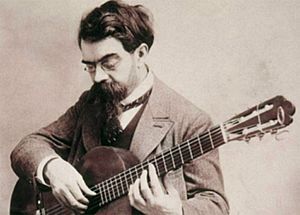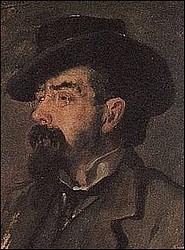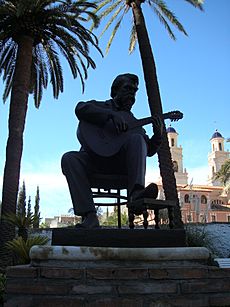Francisco Tárrega facts for kids
Quick facts for kids
Francisco Tárrega
|
|
|---|---|

Francisco Tárrega (before 1900)
|
|
| Background information | |
| Birth name | Francisco de Asís Tárrega y Eixea |
| Born | 21 November 1852 Villarreal, Spain |
| Died | 15 December 1909 (aged 57) Barcelona, Spain |
| Genres | Classical music |
| Occupation(s) | Musician |
| Instruments | Classical guitar |
| Years active | 1874–1909 |
Francisco Tárrega (born November 21, 1852 – died December 15, 1909) was a famous Spanish composer and classical guitarist. He lived during the Romantic period, a time when music often expressed strong feelings.
Many people call him "the father of classical guitar." He is known for beautiful pieces like Recuerdos de la Alhambra. He is thought to be one of the greatest guitarists ever.
Contents
About Francisco Tárrega
Francisco Tárrega was born in Villarreal, Spain, on November 21, 1852. His father played the guitar, and young Francisco loved listening to him. When his father was away, Francisco would try to play his guitar. People called him "Quiquet" when he was a child.
One day, when he was very young, Francisco had an accident. He fell into an irrigation channel and hurt his eyes. His father worried he might lose his sight. So, the family moved to Castellón de la Plana. There, Francisco could take music classes. His father thought that if Francisco became a musician, he could still earn a living even if he couldn't see well. Both of Francisco's first music teachers were blind themselves.
Early Music Adventures
In 1862, a famous guitarist named Julián Arcas visited Castellón. He heard young Francisco play and was very impressed. Arcas told Francisco's father that he should let Francisco study music in Barcelona. Francisco's father agreed, but he also wanted Francisco to learn piano. At that time, the guitar was mostly used to play along with singers. The piano was much more popular in Europe.
Francisco's lessons with Arcas stopped when Arcas went on a concert tour. Even though Francisco was only ten, he ran away! He tried to start his own music career. He played guitar in coffee houses and restaurants in Barcelona. Soon, his father found him and brought him home. His father worked very hard to help Francisco continue his music education.
Three years later, in 1865, Francisco ran away again. This time he went to Valencia. He even joined a group of gypsies. His father found him again and brought him home. But Francisco ran away a third time, back to Valencia. By his early teenage years, Francisco was very good at both piano and guitar. For a while, he played music with others to earn money. Eventually, he went home to help his family.
Studying at the Conservatory
In 1874, Tárrega went to the Madrid Royal Conservatory. This was a special music school. A rich merchant named Antonio Canesa helped him pay for his studies. Tárrega brought a new guitar with him. It was made by a famous builder named Antonio Torres in Seville. This guitar sounded amazing and inspired Tárrega even more.
At the conservatory, Tárrega studied how to compose music. His teacher, Emilio Arrieta, told him to focus on the guitar. He convinced Tárrega to give up the idea of being a piano player.
By the late 1870s, Tárrega was teaching guitar. Some of his students became famous guitarists themselves. He also started giving regular concerts. People loved his playing, and he began traveling around Spain to perform. Around this time, he also started writing his own music for the guitar. He played his own pieces along with music by other composers.
Life and Family
In the winter of 1880, Tárrega played a concert in Novelda, Spain. After the concert, a man asked him to listen to his daughter, María José Rizo, play guitar. Soon, Tárrega and María José got engaged.
In 1881, Tárrega played concerts in Lyon, France, and then in Paris. He also played in London. But he didn't like the English language or the weather there. There's a story that after a concert in London, he felt sad. His friends asked him what was wrong. They told him to put his sadness into his music. This is how he came up with the idea for one of his most famous pieces, Lágrima, which means "teardrop."
After his London concerts, he went back to Novelda for his wedding. Tárrega married María José Rizo at Christmas in 1882.
To have more music to play, Tárrega started changing piano music for the guitar. He changed pieces by famous composers like Beethoven, Chopin, and Mendelssohn. Tárrega and his wife moved to Madrid. They earned money by teaching and playing concerts. But after their baby daughter died, they moved to Barcelona in 1885. In Barcelona, he became friends with other great musicians like Isaac Albéniz and Pau Casals.

Francisco and María José had three more children: Paquito, Marieta, and Concepción. Later, Tárrega met a rich woman named Concepción Gómez de Jacoby. She became a very helpful supporter for him. She let him and his family use part of her house near Barcelona. She also took him to Granada. This trip inspired Tárrega to write his famous piece, Recuerdos de la Alhambra. He first dedicated this piece to Concepción.
Later Years and Legacy
From the late 1880s until 1903, Tárrega kept composing music. But he mostly played concerts only in Spain. In 1900, he visited Algiers. There, he heard a repeating rhythm played on an Arabian drum. The next morning, he wrote Danza Mora based on that rhythm.
Around 1902, he started playing the guitar without his fingernails. This created a new sound that became popular among guitarists who followed his style. The next year, he toured Italy. He gave very successful concerts in Rome, Naples, and Milan.
In January 1906, Tárrega became partly paralyzed on his right side. He did return to playing concerts, but he never fully recovered. He finished his last piece, Oremus, on December 2, 1909. He died in Barcelona thirteen days later, on December 15, at age 57.
Tárrega's Musical Style
As a composer, Tárrega wrote music that fit the style of the late 1800s. He was a "virtuoso" on his instrument, meaning he was incredibly skilled. People sometimes called him the "Sarasate of the guitar," comparing him to a famous violinist.
Tárrega is seen as the person who set the stage for classical guitar music in the 20th century. He helped make the guitar a popular instrument for solo concerts. He preferred playing in small, cozy places rather than big concert halls.
His Compositions
Francisco Tárrega wrote 78 original pieces of music. He also changed 120 other pieces, mostly piano music, so they could be played on the guitar. These are called "transcriptions."
Like some other Spanish composers of his time, Tárrega liked to mix classical music with Spanish folk music. He transcribed several piano pieces by his friend Isaac Albéniz. A modern guitarist and composer, Angelo Gilardino, said that Tárrega's nine Preludios show his deepest musical ideas in a very focused way.
He also wrote a piece called Gran Vals. A small part of this piece was used as the famous Nokia ringtone on many old cell phones!
Guitars He Used
Francisco Tárrega played several special guitars during his life:
- Enrique Garcia, n°74 (1906): Tárrega gave this guitar to his friend Alfred Cottin. He dedicated his famous piece Recuerdos de la Alhambra to Cottin. Later, this guitar was played by other famous musicians, including Django Reinhardt.
- Torres, FE 17 (1869): The famous guitar maker Antonio de Torres gave this guitar to Tárrega when he was 17 years old, after hearing him play.
- Torres, SE 49 (1883)
- Torres, SE 114 (1888): This guitar is part of a collection owned by Sheldon Urlik.
Images for kids
See also
 In Spanish: Francisco Tárrega para niños
In Spanish: Francisco Tárrega para niños






